
MAALEM HOUSSAM GUINIA
DEAD OF NIGHT (Hive Mind)
The youngest son of the legendary Mahmoud Guinia has taken his father's baton and run with it. His latest album was recorded in one take as Houssam sang and plucked his guimbri into the wee small hours, but you don't have to wait until midnight to put this on. The repertoire is traditional tunes he recalled his father playing late at night when he was a child. These are highly evocative moments in childhood (I remember my father unwinding late at night with Sinatra and a glass of whisky). Guinia is locked into a mood and carries it through. There is no percussion or backing vocals that usually accompany such performances, but the pure bassy sound of the gumbri comes through clearly as do his somewhat growly vocals. After appearing at the World Music Festival in Essaouira, Houssam has toured Europe and jammed with musicians from other cultures, as there is a great affinity between the drone of Gnawa music and trance or house music from European electronica producers. This was what put his father on the map, when he collaborated with Peter Brötzmann and Hamid Drake, or Pharoah Sanders, in the late 1980s. Sometimes continuity is better than change, and Guinia Junior is a great advocate for traditional Gnawan music.
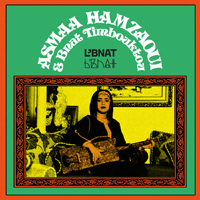
ASMAA HAMZAOUI & BNAT TUMBOUKTOU (EB Music)
Born in 1998, Asmaa Hamzaoui is a young Moroccan Gnawa musician. She may be the first female to record traditional Gnawan music. She sings and plays sentir and guembri, which is that bassy sounding lute. The Gnawa were brought to Morocco as enslaved blacks from south of the Sahara, and their songs relate their history and suffering. Asmaa's father was a master musician and her mother a dancer, so she grew up in the traditions of Gnawan performance, adding backing vocals and qraqebs (or krakrebs, which are those metal castanets) to her parents' act. Remarkably, she put together an all-women group of musicians in her hometown of L'Bnat. This is her second album, that I know of: her debut in 2019 was Oulad Lghaba. The music is familiar traditional Gnawan, which is great for dreamspace. Generally, after an introductory verse and chorus the music picks up tempo as the krakrebs also speed up, and though we can't see the dancers we can sense the frenzy as the tempo builds and builds.
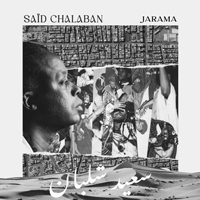
SAID CHALABAN
JARAMA (Argana Record)
This is a Moroccan music showcase of various styles including ancient Gnawa, Shaabi (Moroccan working class music) and Hassani songs, in conjunction with a light backing of Western dub, funk and psychedelic rock. The instigator is Saïd Tichiti, a Moroccan who migrated to Budapest, Hungary, in 1999, where he formed this band, Chalaban. In 2018 Tichiti had the opportunity to return to his home town of Guelmim on the edge of the Sahara. There, close to the border of Mauritania, can be found Bedouin tribes with their Hassani music. He explored the varied musical styles of the area. The Gnawa were blacks from sub-Saharan Africa brought to Morocco as slaves; their music has emerged to become one of the most popular sounds from the region. There is a documentary on line Echoes of the Sahara that follows Saïd on his trip home. Back in Budapest Tichiti put together a rock quartet to back him performing on guembri, lute and percussion. The EP is barely 15 minutes in length, but is a sweet taste of a talented ensemble.
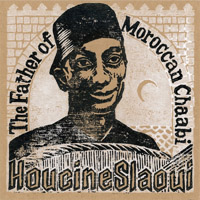
HOUCINE SLAOUI
THE FATHER OF MOROCCAN CHAABI (GOOD OLD NOISE – DJ-001)
This CD comes in a handsome package with a two-color woodcut print on the cover: a portrait of Slaoui (real name Houcine ben Bouchaïb) and detailed liner notes and lyric transcriptions. 2021 is his centenary. Wikipedia gives me his all-too-brief dates, 1921–51 and says he was the first to introduce modern musical instruments into Moroccan music and there are parallels to early Egyptian pop in his music. As a youth he ducked Quran school to listen to street performers; by the age of 12 he was playing a one-string instrument he had made and performing with these halqa street musicians. He visited Paris in the early 1940s but quickly returned to Morocco. After the War he returned to Paris and signed with Pathé-Marconi. He played for the local Maghreb community but also came into contact with others from the Arabic diaspora. He returned home in 1951 and died in mysterious circumstances. Sixteen of 30 known recordings, taken from 78s on Pathé, have been assembled by Doi Naotaka of the Desertjazz blog. These sides were all recorded between 1948 and 1950 and have been lovingly restored. His big hit, "El 'Mericane," is included where he warned about the dangers of the Yankee dollar being worshipped after the Second World War. It sounds better on the CD than in this youtube clip but you can hear the instrumentation: lutar or oud (Slaoui himself), rebab (fiddle), qanun, bendir, darbuk and tbilat, which is the camelskin-covered pottery drum. I found a film clip with him performing and accompanying himself on oud, with subtitles explaining his socially conscious lyrics here. His role as a rwaye (troubadour) was that of poet, comedian and social critic, and he is remembered for bringing chaabi, Maghreb music, into the modern world.
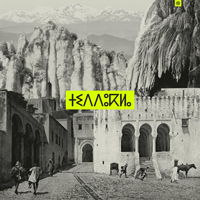
HASSAN WARGUI
TIDDUKLA (Hive Mind Records HMRLP013)
Berber banjo is to the fore on this five track album, which features Hassan Wargui backed by a traditional line-up of guembri, tamtam, bendir and krakch (which must be krakrebs?). Personally I find the combination of guembri and krakrebs irresistible; the added banjo really takes it to another level. Hassan grew up in an isolated community in the Anti-Atlas mountains of Southern Morocco, steeped in the art and culture of the Amazigh people (in a time when it was forbidden to speak their Tachelhit language). In his teens Wargui moved to Casablanca looking for work and was able to trade in his home-made instrument for a real banjo. He has collaborated with many other artists, including more modern techno-sounding outfits, but for this project went back to his roots sound. I've heard Moroccan banjo before (on the Arabic Groove CD), but out of context you might think the opening few bars of "Azmz" was Chinese until the singing comes in. Over the course of the 40 minutes, however, it's got the undeniable Atlas mountain groove redolent of sweet mint tea and the incense of kif.
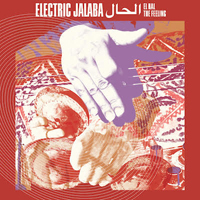
ELECTRIC JALABA
EL HAL/THE FEELING (Strut Records)
With the globe shrinking, it's inevitable there will be more cross-pollination of musical styles. I get pitched new and "innovative" things all the time, often in the guise of "world music"- jazz- or folk fusions. So you have typically a jazz horn player with someone on harp or a virtuoso on a traditional instrument backed by a synthesizer (this was the blight of many RealWorld discs back in the day) and it's auditory pablum. I am not opposed to synthesizers, in theory, it's incongruity that puts me off. I write off such collaborations as misguided attempts, and now am undecided about the latest from Simo Lagnawi. Called Electric Jalaba, it's disco meets gnawa for the most part. Now arabic music has often been involved in fusion: jazz saxophonists played with the Joujouka tribesmen as well as the guimbri player Mahmoud Guinea. Rai musicians were quick to embrace rock and roll instruments. The vocals and general thrust of the music is familiar, the added atmospherics are only a bit distracting for the most part. There are touches of Senegalese mbalax and loads of Jamaican style echo (i.e. sliders to the max on all the instruments and vocals). Mahmoud Guinea shows up here, I assume he was sampled. There are some fine traditional moments, with call and response vocals and basic bass (Olly Keen) or guimbri (Lagnawi) sliding along with krakrebs or drums, but then someone throws a switch on the woop machine. Like halfway through "Shabak," things are going well until they turn on the sonar: there's a submarine beeping followed by cartoonish bloopy underwater effects, then the aimless yelling on echo, like "Anyone down there?" "Can you hear me," except they are not talking in sentences. The problem is the non-Moroccan parts are too diffuse, they become irritating little moments, there's no sustained groove, rather they distract from the actual music, like someone is throwing a bunch of different instrumental textures (even some ersatz pygmy hocketing) at the main tune to see if anything will stick.
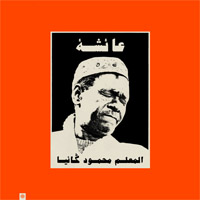
MAALEM MAHMOUD GANIA
AICHA (HiveMind)
It's only posthumously that Mahmoud Gania's work has gained wider appreciation. While available in Morocco on tapes from Tichkaphone and other labels, there have only been a few CDs released outside his homeland, and now here's a second LP of his music from Hive Mind. Gania's music may be very repetitive, but it grabs you by the vitals. His up-front bass-like 3-string Guimbri thuds and pumps while the percussion clacks relentlessly. The krakrebs sound like horses galloping across cobbled streets, but is this a well-known sound in Morocco? I guess it is. And galloping into your imagination, Hive Mind brings us another wonderfully dreamy set, perfect for late night contemplation. It is Gnawa ritual music, with call and response vocals, guaranteed to get the mystics gyrating and moaning along. The Gnawa were brought to Morocco as black slaves so are stateless and landless people who sing about "Sudan," meaning, not the modern country, but black sub-Saharan Africa from whence they were brought. They make a rhythmic and direct appeal to various saints and God, not to mention the prophet Muhammad, crying out for hope, redemption and spiritual grace. The lyrics are presented in the booklet, with translation, which is a plus, but quite often turn out to be simply "A bangara bangara / A bangara bangara / A bangara bangara / A bangara bangara," which may not even be comprehensible to initiates. Gania worked in many musical contexts: alongside jazz musicians who sought him out (even if they couldn't communicate with him verbally) or in weird hybrid world music mixes, such as the psychedelic cassette you can find on the "Moroccan tape stash" blog, but what he does best is this all-night trance music perfectly captured here.
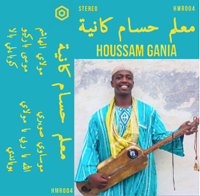
HOUSSAM GANIA
MOSAWI SWIRI (Hive Mind HMR004)
A young guy I know (not sure if he qualifies as a hipster) is now fanatically into cassette tapes. Cassettes were another format that was replaced by CDs and then digital media, but were always in favor in Africa (less likely to get scratched, warped or dusty than vinyl). Now Hive Mind has brought back the cassette in a limited-edition release of Gnawa music that is even making a stir on bandcamp. While on the plus side cassettes of music don't get scratched or stick (though they can stretch or break); on the minus side they were usually dubbed at high-speed on gunky decks on the cheapest-available blank tapes and so sound like mud. At least many of my Tanzanian cassettes have those problems. Houssam Gania is the youngest son of the late master musician Maalem Mahmoud Gania, who was sought out by Randy Weston, Peter Brötzmann, Bill Laswell and Pharoah Sanders (seperately!) when they became entranced by Gnawa music. Young Houssam has mastered the meditative groove on the bassy 3-string guimbri, so dont expect pyrotechnics on here, just a solid slab of ritual music, thick and sticky as black hash, but as bright as the sun on breaking waves on the beach of Essaouira. His brother Hamza plays percussion, as do others who add qraqabs and chorus behind Houssam's vocals. The opening cut also adds guitar, keyboard and drum kit for a taste of Essaouira fusion. If you don't fancy cassettes, or have a deck any more, it's also available as download in trusty intangible digital formats.
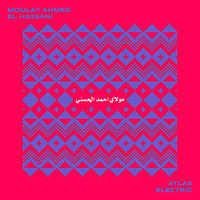
MOULAY AHMED EL HASSANI
ATLAS ELECTRIC (HiveMind Records HMRLP003)
Quite unknown outside Morocco, Moulay El Hassani has been recording for 30 years releasing over 50 cassettes and CDs. Now Hive Mind has dug through his archive and put together a 2LP set of a dozen of his tunes. It's modernized folk music: he sings sweetly and plays guitar with a lot of Echoplex, creating washes of sounds that float over a staccato beat of tambourine and hand drums, augmented by synthesized percussion. The backing vocals are also auto-tuned and run through the Echoplex which is not as awful as it sounds: it's just another sonic layer to play with. The guitar tuning is more lute-like or maybe that's because it's an opening tuning. The songs remind me of gentle Rai, but are also related to Amazigh music of the middle-Atlas region. As the label suggests: "The resulting sound is like a twenty-first century folk music for a people caught somewhere between a vision of their own idealized pastoral past and a turbo-charged, technologically driven urban future."

MALEEM MAHMOUD GANIA
COLOURS OF THE NIGHT (Hive Mind Records HMRLP001)
Finding new music from the Moroccan master of the three stringed guimbri is always thrilling and I have been looking forward to this for months. However my thrill in hearing it is tempered by the fact that it is his final recording. Doubtless there are tapes floating about which may come to light but we will not have the joy of knowing he is still creating his trancelike music in all-night sessions in the medina. This LP and digital issue comes from HiveMind, a new label in the UK. It's Gania's first solo vinyl issue and is rich and warm with the beautiful sounds of his pulsing bass-y instrument and the accompanying finger-cymbals. Born in 1951 Gania grew up in Essaouira on the West Coast of Morocco. His family are descended from black Africans enslaved to work in Marrakech, but who brought musical traditions from sub-Saharan Africa with them. Their choral singing is accompanied by drums and the metallic clack of the relentless krakrebs. Maleem (or Maallem) means "master musician" and Gania was the acknowledged star of his style of Tagnawite music so made numerous recordings (though only three are listed on discogs and not his blistering self-titled CD "Mahmoud Guinia" that came out in France on Casa Maroc in 1992). He was sought out by Pharoah Sanders, Peter Brotzmann and other top-flight jazz musicians for collaborations. His Gnawa brotherhood are unorthodox Sufis, a sect of Islam with roots going back to the first muezzin to Mohammad who was an Ethiopian. The bases are loaded, and the hypnotic rhythms induce a spiritual intoxication of religious passion that leave you open -- to God, to enlightenment, to some form of transcendence. Curtains to the cosmos are drawn back as the infinite waits to nebulize us.
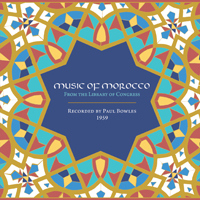
MUSIC OF MOROCCO
RECORDED BY PAUL BOWLES 1959 (Dust-to-Digital DTD-46)
Paul Bowles is best known as an American author who lived as an expatriate in Morocco where there would be no scrutiny over his homosexual lifestyle, and that of his wife, Jane (also a fine novelist: see Two Serious Ladies). He was surrounded by others who shared his attitudes, such as British author and painter Brion Gysin, and American William Burroughs, who wrote Naked Lunch while there. "Compared to Tangier," Robert Ruark wrote, "Sodom was a church picnic and Gomorrah a convention of Girl Scouts." Bowles also had Moroccan houseboys, Mohammed Mrabet and Larbi Layachi, who told him folk tales which he tape-recorded and translated into best-selling books. Gysin ran a cafe, the 1001 Nights, and had Gnawa and Joujouka musicians perform there which appealed to Bowles who had been a serious composer earlier in his career. His love of music and ability with a two-track recorder led to sixty hours of 7-inch tape which he made for the Library of Congress in 1959, and which led to their 2xLP field recording set Music of Morocco (1972). That has now been updated into this deluxe 4xCD package. I don't know why Dust-to-Digital felt it necessary to give 4pp of space to Lee Ranaldo to write an "introduction" since he basically says he cannot read Bowles and knows nothing about him. That left a bad taste and did not endear me to the fancy over-the-top booklet bound in fake leather. But it's not all flash and no substance: Philip Schuyler writes a more thorough introduction, mentioning the urgency Bowles felt in 1957, the year after independence, to capture the indigenous music before it was lost to progress, and the impinging influence of Egyptian pop. Bowles bought 78s of local music but it didn't satisfy him so he hit on the idea of making his own recordings. He even sent recordings to Bela Bartok who stole ideas for his "Concerto for Orchestra," as many European composers from Dvorak on down had done to other folk music. On a trip to the USA to deliver incidental music for Tennessee Williams' "Sweet Bird of Youth," Bowles visited the Library of Congress and got training on the Ampex 601 deck. There were two obstacles that stood in the way of the project: the first was electrical power since the Ampex had to be plugged in to 110 volts (American isolationism again!), and the second was official meddling and locals suspicious of whitey with a machine. This meant that often he had to set up a studio in a hotel and persuade musicians to come to him and perform. He also tried to manipulate the artists, telling them the American government wanted certain instruments to play solo and moving others he didn't like out of earshot! You don't need me to repeat the names of the different types of indigenous instruments, flutes, reeds, drums, heard here, but it is a unique and to use the hackneyed word "magical" sound. Once his six-month odyssey was completed Bowles had many hours of music (250 tracks, many over ten minutes long) and urged the Library of Congress to put out 6 albums. His friend Ira Cohen wanted to issue an LP of secular trance music but, again, Bowles wanted too much control over what this would include. There was a certain patronising "Orientalism" -- or racism to put it bluntly -- in Bowles' view of Berber music as barbaric and primitive, but he meant this is a compliment. He was looking for something pure and essential, untainted by outside influences. For this new edition the LC discs have been revised. There are eight additional pieces, and two pieces have been replaced by others of better sonic quality, so this is really an upgrade. And now all the tracks are full length instead of edited for time (forget the notion that repetition gets boring!); as Bowles wrote, "There is no quick way of listening to Berber music." I agree, and it is a delight to steep in this heady mix of mental mint tea and kif-wreathed percussion.
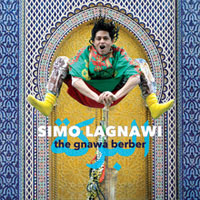
SIMO LAGNAWI
THE GNAWA BERBER (Riverboat TUG CD1086)
This is traditional North African music. Simo Lagnawi is a Berber, a native of Morocco, and student of his country's musical traditions. He has studied Ahwash chants and Gnawan musical modes. In 2008 he moved to UK, taking his guembri with him. That's the pulsing three-string bass you hear on Gnawan music, which is usually played at all-night session as a way of invoking the spirits. The groove is unstoppable and certainly trance-inducing with the wildly clacking krakebs and thudding animal-skin drums propelling it. The looping, loping rhythms quickly hypnotize the listener and there's enough echo on the vocals to make you feel time has been suspended and you are just floating in the warm air above the Sahara desert. For variety there are some Hausa and Bambara tunes drifting up from further South across the sands, where the Berber also lived. Famous Berbers include Saint Augustine and Zinedine Zidane. The Berbers are widely dispersed today. This is a richly dense, well-conceived and well-executed album. There are also guest appearances by a flautist and a banjoist, as well as a fiddler, which all fit in nicely as cousins of African instruments.
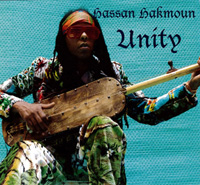
HASSAN HAKMOUN
UNITY (Healing Records)
Maybe not the best, but perhaps the most famous Moroccan musician playing today, Hassan Hakmoun has taken the traditional Gnawan music he grew up with in Marrakesh and gone rock n rolly with it. In the past he has collaborated with Peter Gabriel, Don Cherry and, of course, the Kronos Quartet. In 1987 he played Lincoln Center in New York and was so well received that he decided to move to the US. He plays a three-stringed lute called the sintir, a bassy instrument. In 1991 his Gift of the Gnawa stormed the world music charts but since then he has been acting and backing other performers. Here he take almost a Led Zep approach to the music, with blues harp, crunching electric guitar and tumultuous drumming. Apart from his wood and camelskin axe, there are some other traditional instruments on here: karkaba, two sabar drummers and a Fula flute. The Mali/Senegal connection makes sense because the Gnawa were originally black slaves imported to Morocco from West Africa and I suppose the rock connection is there because Hakmoun is now an American. The album sounds live and spontaneous (it was recorded in three days) and bristles with energy. Producer is Yossi Fine who played bass with an outfit called Ex-Centric Sound System and is also in Avila. He wanted it to sound like it was recorded in Africa years ago, i.e. with an overmodulated bottom! The most "traditional" tracks like "Boudarbalayi" are fine; a couple of the rock tracks seem excessive. The Soul K Remix of "Balili" is also unnecessary: it just throws incessant soukous-style drumming on top of the track until you yell Uncle.
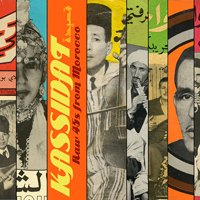
KASSIDAT
RAW 45s FROM MOROCCO (Dust to Digital DTD32)
This is Berber music from the 1960s before Western pop had a chance to impact it. After Morocco gained its independence from France in 1956, Moroccan-owned record labels sprang up in Casablanca and flooded the market with 45s of traditional music. There are six tracks on here, so it is only a 34-minute album, but it is intense. The elegant package includes detailed liner notes and replicas of the picture sleeves of the originals. "Kassidat" the title, is Arabic for "poetry," and the lyrics are the poetic expression of everyday life of the Berbers. "Berber" itself is the Greek work for Barbarian, so the locals prefer to be known as "Imazighen." I don't know if this approach is intentional, but Dust to Digital have given the job of compiling their latest Arabic CDs to experts in Southeast Asian music (reminds me of Portsmouth Sinfonia), which makes you wonder if they could have got better results from getting in touch with serious specialist collectors, but then again a fresh approach is often necessary. While it is short and sweet the liner notes suggest solid research behind the collection assembled here.
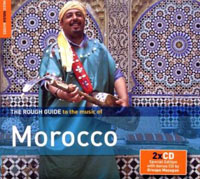
ROUGH GUIDE TO MOROCCO (RGNET1266DD)
Among its many peregrinations across the globe, Rough Guide returns to North Africa for a fresh look at the scene in Morocco. The music scene there is thriving: both traditional and modern sounds are sampled in songs culled from the last decade. The traditional rap that opens it is not to my taste though the instruments are familiar. There's another noisy entry called "Boolandrix" that demonstrates the enduring appeal of Jimi Hendrix on aspiring guitarists -- sadly none of them are a patch on the original. The big boomy sound of Amira Saqati is appealing on the grooving "Al Aloua"; but one question keeps coming up and that is, Does mint tea and kif make you this speedy? Finally we get to the soulful krakrebs and guimbri sound that I find so satisfying -- here it's "Bania Bambara" performed by Maalem Said Damir & Gnawa Allstars. But all things must pass and we are thrust into the horror of a heavy metal rap called "Jil Jdid" by H-Kayne -- a noisesome racket about the appeals and dangers of the internet. Skipping that we come to a classical vocal track "Mal Habibi Malou" by Samy Elmaghribi which is poorly recorded but you can still get the impact of his voice, though the instruments are lost in the background. The only familiar name is the Master Musicians of Joujouka who anchor things with a final trancelike whirl of their flutes and drums. I am ready to discover new artists but if you are already into Moroccan music I suggest you skip this offering.
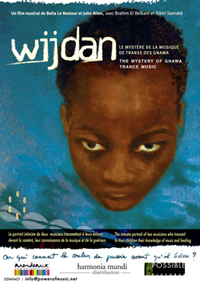
WIJDAN
LE MYSTERE DE LA MUSIQUE DE TRANSE DES GNAWA (Possible Pictures DVD)
This musical film, by Bella le Nestour and John Allen, makes such an obvious connection you wonder no one thought of it before. The Gnawa are Black Moroccan master musicians. Their music, like that of the Joujouka, is old as the hills and imbued with ancient rituals, so ancient that many of the musicians have forgotten what they are singing. This is because they sing in Bambara, a tongue that is seldom used outside Mali. Centuries ago they were brought north as slaves and never fully integrated into the culture and religion of their arab masters. And in Mali there are still musicians who keep to their ancient traditions in song and dance. So Bella Le Nestour had the idea to find a Malian musician and take him to Morocco to see what came of this encounter. The result is this riveting documentary which buzzes with rich performance and the insinuating drone of the guimbri and krakrebs (those metal clackers that drive the beat). Though I gave up smoking hash years ago, the first note of this music is like a deep hit of the black tar and time and space are suspended. The guimbri is a cousin of the kamele ngoni. The player found by the film makers is Sibiri Samake, the chief of the Hunters in his Bamako tribe. He inherited the post from his father. The Hunters protect the roads and worship animal spirits: you are probably familiar with their wild get-up. Sibiri is a self-taught musician as he is not of the musician caste, but he is a fine player on the ngoni. The producers took him to Morocco, to meet Brahim Belkani, who is descended from a long line of musicians, and has a house full of singing and dancing children who are his accompanists. One of his daughters eloquently expresses herself in English for she spent a year abroad studying at UCLA, her only connection with home being a Gnawi cassette she listened to endlessly. The camerawork is a little limited and unimaginative, but the editors have added out-of-focus shots and clips from other documentarians' work to flesh it out. Above all the music is excellent and this is a fascinating and fulfilling look at how these two cultures were separated and now come together again.
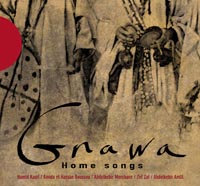
GNAWA HOME SONGS (Accords Croisées AC117)
More North African music, in a package you will want because of the detailed liner notes and photos that will enhance your listening experience. There are four main artists on here. I had not heard of any of them, but the sound is familiar and I love this late-night trance music. The Gnawa were black slaves brought from Mali and still sing their songs in Bambara, though it is not their everyday tongue. They play and sing all night and the kif-toasted members of the audience go off into trances. They praise Allah but retain the right to speak to the djinns or genies that are part of their traditions for three centuries since they were transported to the Maghreb. Every year the greatest musicians in Morocco gather for a festival of sacred music in Tamesloht and on this occasion four of them sat around one night trading songs. The cyclical bluesy 3-stringed guembri seems barely awake on some numbers and even the metal castanets (qraqebs) are muted. This is a beautifully recorded, perfectly sequenced, and handsomely packaged set.
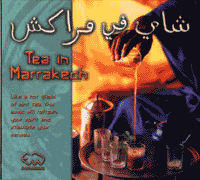
TEA IN MARRAKECH (Earthworks)
Earthworks has issued a fine compendium called TEA IN MARRAKECH. I liked this immediately because many of the tracks are familiar and it's always fun to relinquish the programming to someone who knows what they are doing. The focus is on North African music of the last decade of the twentieth century. For most of the twentieth century the grandiose Sharqui music of Egypt was the dominant strain, but in the sixties Rai music from Algeria and Moroccan Sha'bi music gained ascendancy, particularly as the North African diaspora continued after the wars with the French. In Paris, Arab musicians came in contact with other influences while groups like the Stones and Led Zep followed pilgrims Brion Gysin and Paul Bowles to Morocco looking for music, kif and dark holes to hide in. There are some top hits on this album, from Setona's "Tarazina" to Sawt el Atlas's "Zmane y dore," but the overall presentation is wonderfully balanced between familiar ditties and surprises. Two of my favorite Algerian ex-pat bands, Orchestre National de Barbes and Gnawa Diffusion, are included. The former with "Poulina," the title cut from their 1999 album; the latter with a cut from their essential BAB EL OUED also from 1999. Morroco itself it represented by Nass Marrakech (who are based in Spain, keeping their traditional Gnawan music alive in Barcelona). Salamat from Egypt perform "Noura" a light acoustic ditty that is the "Marrakesh Express" of this set. There's a strong traditional undercurrent to the compilation but most of it has a pop sheen, typified by Rasha, a Sudanese singer who has been compared to Billie Holiday and Cassandra Wilson. Without getting into hyperbole let's just agree she has a warm soulfulness to her voice. The sax accompaniment is "Quiet Storm" jazz but goes down smooth, like illicit liquor in the Nubian Desert. TEA IN MARRAKECH is a superb compilation worthy to stand alongside the previous great sets from Earthworks.